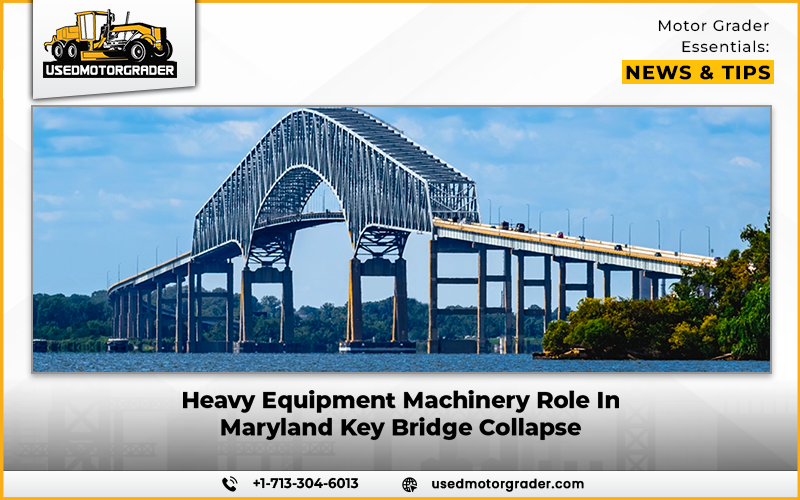The Francis Scott Key Bridge in Baltimore, Maryland suddenly collapsed when a Singapore-registered container vessel called MV Dali fell. At 1:28 a.m. on March 26, 2024, the incident occurred. In this collapse, two workers were saved by the rescuers while six lost their lives in due course. Maritime traffic completely ceased when the Port of Baltimore shipping lane remained blocked for 90 days after the disaster. It was a critical issue that affected the business procedures also leading to the infrastructure structure which was designed while the transportation systems were undermined. In the aftermath of such a disaster, Maryland state authorities pointed out that the reconstruction process through heavy equipment machinery would have to be overhauled and safety standards would have to be made tighter.
The Tragic Collapse and Its Immediate Consequences
The Francis Scott Key Bridge suffered a fast and catastrophic breakdown. The MV Dali’s power loss caused its impact with the southwest pier which sent a major part of the bridge structure crashing into the Patapsco River. The accident fully closed the shipping channel and stopped every vessel from moving through the Port of Baltimore. The Port of Baltimore suffered severe economic losses of $15 million per day for 11 weeks because a blockage permanently halted its operations. Traffic from the collapsed bridge had to travel through alternative routes such as the Harbor Tunnel and the Fort McHenry Tunnel, which became overloaded and faced traffic jams totaling 34,000 more daily crossings. Immediate operations were performed by the available heavy equipment machinery such as cranes, excavators, and road construction motor graders to clear out routes for alternative travel.
The Investigation and Legal Repercussions
Officials started thorough investigations to find the reason behind the collapse plus identify who should accept responsibility. The initial inspection showed that before the crash the MV Dali hurtled with severe problems in its mechanical and electrical systems. The U.S. Department of Justice sued Grace Ocean Private Limited of Singapore and its subsidiary Synergy Marine Private Limited for damages. The lawsuit proves that poor vessel upkeep invited a major power breakdown that wrecked the bridge. The U.S. government demands more than $100 million to pay for cleaning up the port and getting it back into operation. The case shows how poorly run international ships affect maritime safety and need stronger rules for vessel upkeep when entering U.S. waterways.
Economic and Transportation Disruptions
When the Francis Scott Key Bridge suddenly failed, it caused major damage to Maryland’s transport system and business processes. Because the Francis Scott Key Bridge connects Maryland’s daily traffic, it raised congestion on all routes and stretched journey times. The Port of Baltimore completely halted its trade port operations and this severely harmed the national and regional economic systems. The port’s shipping industry and its business partners suffered shipping holdups that destroyed profitability for enterprises dependent on this route. During the 11-week closure, people from all sectors lost $15 million showing how the choice affected everyone. State and federal authorities have increased the cleanup rate at the channel, yet full restoration will take several years to complete.
A Recent Engineering Strategy Builds the Bridge Back
Maryland officials introduced a new bridge design to replace the damaged one in February 4, 2025. They will build a strong cable-stayed bridge using two tall towers connected to separate cables. To boost bridge safety and let taller vehicles pass under it. Modern engineering systems within the new bridge structure will prevent collapse issues from happening in the future and this will require advanced heavy equipment machinery. The updated bridge system contains reinforced protection pillars made to withstand stronger impacts from larger vessels. The construction project will reach $1.7 billion in total expense with federal funds paying part of the rebuilding expenses. The new bridge system will take four years to build. From 2024 through 2028 and will generate employment for thousands of Maryland residents as they reconstruct their damaged economy after this event.
Broader Implications for Infrastructure and Policy
The collapse of the Maryland Key Bridge led officials and stakeholders to think deeply about national infrastructure protection and government improvement. The accident proves the need to inspect bridges regularly while checking all ships reported and maintained safely. Officials at the state and federal levels are creating new rules to verify. That vessels maintain proper operational and maintenance standards before reaching U.S. ports. The national focus now targets bridge and transport network enhancement to strengthen them against natural and human-made threats. New infrastructure development on the Francis Scott Key Bridge marks a crucial period for traffic safety. The state by showing that action must be taken to prevent future accidents and protect lives.
Lessons from the Collapse: Engineering and Safety Measures
The Francis Scott Key Bridge gave authorities important insight into the weak points of their infrastructure system and waterway safety. The engineers found that the bridge lacked enough backup systems to support its structure in the original 1977 bridge design. The Key Bridge did not contain modern safety features like modern bridges which also resulted in the collapse. Experts in engineering and government are now taking steps. Set tougher building requirements to make new and important projects stronger, safer and able to withstand disasters. The incident encourages people to think of better tools for ship steering control. Plus, analyzes how officials should regulate boats and provide better rescue teams for boat accidents. Building the new bridge will not only repair Baltimore’s traffic system. But also provides an opportunity to develop state-of-the-art engineering solutions for all U.S. infrastructure projects.


